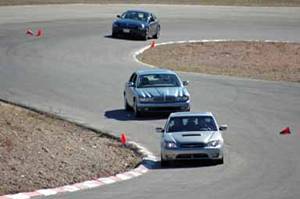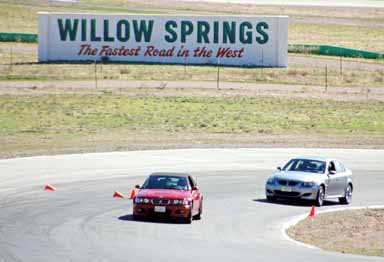
Track Days: Street Cars, Race Cars & Karts
Those of you who race – on a professional or even an amateur level, probably are well aware of what a Track Day is. However, for the benefit of those of you who may not know, a Track Day is an opportunity for participants to drive on a race track.
Car clubs tend to have these from time to time. The club rents a race track and members, for a relatively small fee, may drive on the track – either in their own cars or perhaps in borrowed or rented vehicles. These are not always purpose-built race cars. Track days are often an opportunity for people to take their street cars on the track and drive them at speeds that exceed the speed limit on public roads.

I remember one such Track Day long ago, back when I lived in Alberta, Canada. At the time I owned an aging and pretty well worn-out Datsun 240Z. The car had been bought very used, with the intention of using it for autocrosses. Getting the chance to drive it on a race track (Edmonton International Speedway, a noteworthy track that ceased to exist over twenty years ago) meant that I could learn how well the car handled, and what its weak points were so that I could have them addressed.
Well, it didn’t take me too long to learn what the car’s biggest weak point was. I had been doing high speed hot laps, learning the track’s turn-in and braking points, and where I could drive flat-out. It was during one burst of hard acceleration that I began to detect a banging noise – even though I was wearing a very well insulated helmet. About the same time that I heard the noise, the car suddenly lost its ability to accelerate and that was that. The motor was blown.
That is but one downside of track days. By pushing a car to its limits, you stress its various components to their limits too. That can be expensive – and not covered by the manufacturer’s warranty. That is why I like attending Track Days in other people’s automobiles, but only under certain circumstances.
If I borrowed a friend’s car and it broke, I would feel badly and obligated to pay for the damage. That is why I rarely borrow people’s cars. It is one thing to pay to fix your own car. It can be much more aggravating to pay to fix someone else’s. Also, if I borrowed people’s cars to use on a track, I would feel somewhat obliged to lend them mine for similar use.
A personal example illustrates one problem with that. More than 15 years ago I owned a Mustang with a V-8 engine and a manual transmission. I had special-ordered the car to optimize it for autocross use at what was then San Diego’s Jack Murphy Stadium (now Qualcomm Stadium). I changed out the exhaust system for a louder one – to marginally improve performance but, more importantly, to help get my adrenaline pumping (listening to the sounds of a throaty exhaust produces a similar effect in me as listening to music with a fast, strong, repetitive beat). I also put a set of dedicated autocross tires on a separate set of wheels. Those tires are sticky and, even under the best of circumstances, do not last very long. Well, someone who had autocrossed for years wanted to try out my new Mustang. Because of his experience I trusted him to take care of my car. What I failed to take into consideration was his lack of familiarity with my car. Sure enough, shortly after he started his autocross lap and approached a sharp, right hand turn in the course, he left his braking point too late, hit the brakes too hard, broke traction and locked the wheels up – causing the tires to skid. Unfortunately, instead of sensing what he had done, lifting off the brakes and simply continuing harmlessly off the course, he tried to turn anyway and continued to skid. The result, which I saw when he returned from his run, was several flat-spotted tires where he had skidded on them. Round tires roll, flat-spotted tires bounce. They were ruined and he did not offer to pay me for them. I have rarely lent my autocross car to anyone since.
However, I suggested that there are certain circumstances under which I will borrow cars for track use. As an automotive journalist, one of my perks is that auto manufacturers bring out many of their hot new vehicles once a year to California’s Willow Springs International Raceway. They did that recently and I had a blast. The only catch that the organizers impose is that if you skid off of the track, your track privileges will be pulled for the remainder of the event. That serves to keep most people’s lead-foot tendencies in check. Only one person was so punished at this year’s Track Days.
I drove a wide variety of vehicles on and off the race tracks (Willow Springs has more than one). I also got a ride in a Cadillac CTS-V race car, with a professional race car driver at the wheel.
Riding in the race car was a neat experience but it was actually more exciting to drive myself on the track – even in much lesser automobiles. The professional knew the race track, the limits of his car and his ability, and drove accordingly to ensure the safety of his many passengers. When we drove, however, we were often in unfamiliar automobiles and were pushing them towards the limits of our abilities. That is both a scary and exciting prospect, especially when other cars are approaching from behind. Do you go faster and risk leaving the track, or continue to drive with cars filling your rear view mirrors? I chose the latter.
For what it is worth, I will give you certain memorable impressions that I had of a few of the vehicles, in no particular order. One that I really liked was a slightly modified Datsun 350-Z. The car really felt balanced and predictable, with good handling, confidence-inspiring braking, quick acceleration and easy gear shifting. Just out of curiously, I then tried driving a regular 350-Z. It was a disappointing experience. The tweaks to the first car really improved it over the stock version. If I were to buy one, I’d spend some money on modifications. They transform the car into a real performer.
Another car that I’d been wanting to try for quite some time was the BMW M3 with the SMG transmission. That transmission supposedly offers the benefits of an automatic in traffic and the capability for positive, manual, delay-free gear changes for track use or spirited driving. The result? In my opinion, forget it and save your money. If you want or need an automatic, the SMG transmission is not a direct replacement, and on the track at speed I could not get it to work it as easily or as smoothly for manual shifts as a regular manual transmission.
While GM did not make any available for us to drive on the race tracks, they did bring along a couple of Corvette Z06s for us to drive on the surface streets and nearby highway. What a glorious rush driving the Z06 is. I’ve never been for a ride in a jet fighter but I have had rides from time to time in race cars. This car accelerates like nobody’s business. Put it in first. Accelerate hard and almost immediately it is time to shift. Shift into second and do it again. Almost immediately you’ll have to shift to third. By then you’re almost driving too fast for public roads. The only problem I experienced with the car was having a low tire air pressure warning displayed. If you want a street legal race car, this is the one to get but be prepared for lots of restraint and frustration, or to lose your driver’s license.
Another highlight of my Track Days experience was driving a fast kart on the kart track. Man those things are quick and fun! If you think about it, speeding along without the protection of a seat belt to hold you in seems crazy, but from behind the steering wheel that thought disappears from mind. What replaced it for me was the sincere hope that the brakes would work, to counter the awesome acceleration before turns. To get really quick laps takes some practice but even after my first lap I began to feel like a real racing driver. What a rush! I’d like to take this opportunity to once again thank Mike Manning for giving me this experience. He runs Mike Manning Karting – a full service kart shop right at the track in Rosamond, California. For your own karting experience and to learn about racing with the Willow Springs Kart Club, you can reach Mike at (805) 256-7500.
Vendors, including Mother’s (polishes, waxes and cleaners) and Michelin, were there to show off their products to the assembled members of the Media. I didn’t know, but in addition to tires the Michelin name can also be found on what appear to be high quality car accessories and even clothing – including tennis shoes. In particular I was impressed by their “Alloy Digital Tyre Pressure Gauge” – “accurate to plus or minus one PSI.”
Before leaving the area I visited XCOR Aerospace, on the flight line at the Mojave Airport. What a cool place. They recently built the “EZ-Rocket” – “a manned, flying rocket powered airplane.” Particularly noteworthy is the fact that the “vehicle is capable of stopping and re-starting engines in mid-flight, as well as performing rocket powered touch and goes.” Their goal is to develop the technology for “profitable transportation to Earth orbit.” I think we’re going to see big things from this technology in the not-too-distant future. As you will see at www.xcor.com, their website is fascinating. One headline reads “XCOR to build Rocket Racing Vehicles for Rocket Racing League.” While at the airport I also noticed an airplane ‘boneyard’ filled with old passenger airliners.
Drive safely and do join me again next time.








